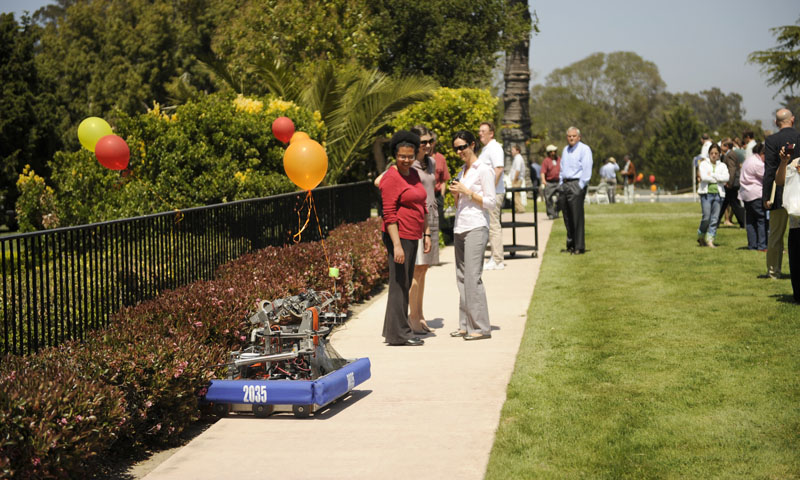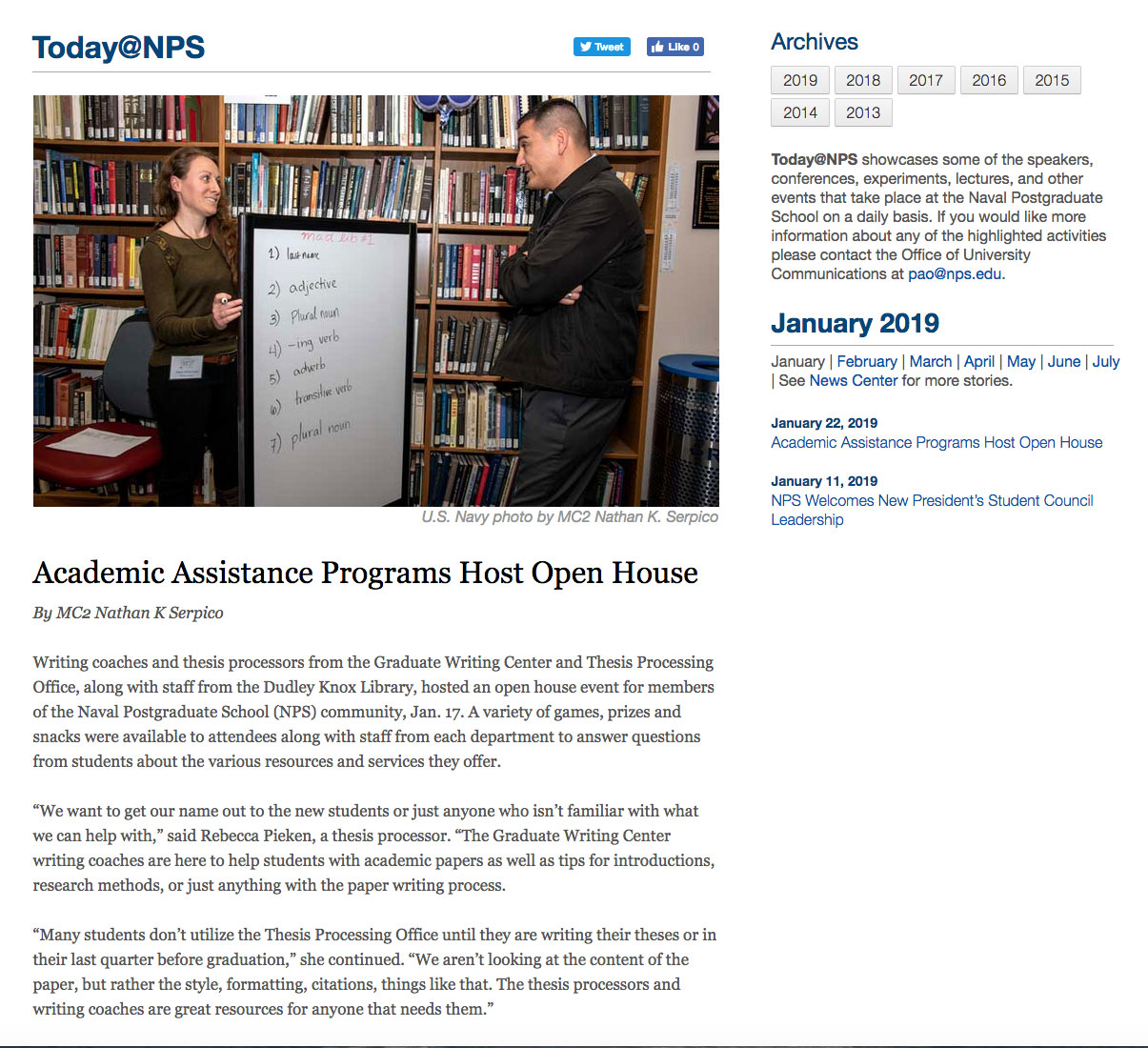The Naval Postgraduate School (NPS) Consortium for Robotics and Unmanned Systems Education and Research (CRUSER) recently reached a program milestone – it signed up its 1,000th member.
CRUSER began just two years ago with seven members, and has since ballooned into a clearing-house of sorts that provides both a collaborative environment and a community of interest for the advancement of unmanned systems education and research.
“In February 2011, Under Secretary of the Navy Robert Work charged NPS to create a DOD-wide community of interest to exchange research and experimentation results for unmanned systems,” said retired Navy Capt. Carol J. O’Neal, director of CRUSER concept generation and innovation.
CRUSER’s interests, and those of its members, are far-reaching and intricately detailed. While some of its efforts are nearly indecipherable to the uninitiated, and others could be mistakenly dismissed as science fiction, CRUSER is not just a place for abstract theory. Its researchers are grounded in the Navy’s most critical missions and are looking for workable solutions to Navy, Marine Corps, and defense-related problems.
“CRUSER is an inclusive community … It encompasses successful research, education and experimentation efforts in unmanned systems currently ongoing at NPS and across the naval enterprise,” said retired Navy Capt., NPS Professor of Practice and CRUSER Director Jeff Kline.
Members of the CRUSER community at NPS include both researchers from the uniformed services and academia. Outside NPS, the CRUSER community has members from all branches of the military, several government agencies, industry, other academic institutions and beyond.
On campus, monthly CRUSER meetings provide a forum to discuss relevant student research across any number of disciplines. Coast Guard Lt. J.B. Zorn’s research in systems engineering was featured at the most recent meeting, and is representative of the kind of discovery that CRUSER encourages and supports.
“When I came here, I really wanted to do something impactful for the Coast Guard,” said Zorn. “We have a wide range of missions related to both military and law enforcement functions … I am looking at how the Coast Guard can utilize unmanned vehicle technology to meet the Coast Guard’s mission needs.”
Zorn is exploring Coast Guard concept and capability needs, and developing a holistic perspective on unmanned maritime systems. His studies have led him to unmanned vehicles that can perform everything from hull inspections to detecting and cleaning an oil spill.
CRUSER Director for Research and Education, Assistant Professor Timothy Chung, is working across academic and technical disciplines on a slew of robotic platforms. Current students, faculty, and even local high schoolers, helped Chung launch NPS’ Advanced Robotic System Engineering Laboratory (ARSENL), part of the systems engineering department.
“The lab opened June of last year with an army of interns and my research team,” said Chung. “We were test flying in just three months, and what see you see here is the result of seven months in a rapidly changing technological environment.
“Our vision is to help integrate across the campus, as CRUSER is about breaking down boundaries and bringing people together,” he continued.
Chung stressed that part of CRUSER’s mission is to not only make technological advances in unmanned and robotic systems, but to make our military student body more aware of emerging technologies, including their capabilities as well as their limitations. As federal purse strings tighten, unmanned solutions are getting a lot of attention both within and outside the DOD.

A non-human CRUSER member offers a gift to another attendee at last year’s Robots in the Roses Research Fair. CRUSER fairs encourage research and collaboration in robotics and unmanned systems, with the next taking place on the NPS campus, April 11.
NPS Graduate School of Business and Public Policy student, Navy Cmdr. Gary Lazzaro, is working with CRUSER to explore the manpower requirements of unmanned versus traditional systems. This seemingly ambiguous question becomes increasingly important when considering the cost associated with manning advanced systems.
“Manpower costs can be up to 70 percent of a project’s total cost,” said Lazzaro, whose findings reveal an enormous financial disparity between manned and unmanned systems. According to the March 2013 graduate, the manpower costs of operating a squadron of five UCLASS unmanned aerial vehicles is between $29.4 - $61.4 million less than the cost of operating a squadron of five F/A 18 Hornets.
Financial efficiency is just one very small part of the outlying regions of a broad spectrum of unmanned and robotics systems research. And it’s a widening body that CRUSER believes will only continue to grow, underscoring the need for continued unmanned vehicle research at places like NPS.
Lyla Englehorn, a program manager with CRUSER, helps guide current and prospective members as they explore unmanned systems related research and concepts at the university.
“Selected concepts of interest are put out to our technical community of interest. They propose how these concepts might actually work, then proposals of merit are brought to field experimentation to see if they actually do work,” said Englehorn.
Englehorn believes that innovative concepts are generated when there is appropriate academic support. CRUSER seeks to provide that support and encourages innovation through a series of workshops and events. CRUSER’s Warfare Innovation Workshop is indicative of the group’s approach.
“We designed an innovation workshop to challenge junior officers and early career engineers to push around in the outskirts of the adjacent possible to find something worth investigating further,” said Englehorn. Further examples of CRUSER’s commitment to collaboration are the upcoming annual Robots in the Roses Research Fair and Technical Continuum (TechCon).
Robots in the Roses provides a venue for NPS students and faculty to demonstrate their research in unmanned systems or robotics to the broader campus community. All students are invited to attend and explore what is available, with researchers welcoming those interested into their specific areas.
TechCon is a seminar-based program that provides a forum for NPS faculty to propose research areas for CRUSER sponsorship the following fiscal year. NPS students are also encouraged to present their research at this forum.
Concepts presented this year will include, amongst other things, decoys and military deception, vessel tagging, non-lethal kinetic effects, navigation and timing, autonomous docking, and hybrid unmanned vehicles.
Anyone interested in participating in these events or joining the CRUSER community may contact CRUSER Operations via e-mail at cruser@nps.edu.


